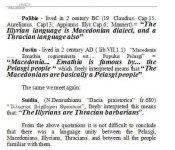RagnarofMacedon
Regular Member
"Macedonians/thracians/illyrians were all proto-slavs" is a good conclusion?
And I agree, Harl js a serious historian, but in the very lecture you shared he explicitly states that slavs have nothing to do with macedonians unless some assimilated locals.
Lecture is connected about MACEDONIANS Are GREEKS nonsense i reading everywhere , its clear that nowdays noone is clear NATION, there were too many people on balkan coming , but we talking about fundamentals of one nation , fundamentals of North Macedonians are ancient Macedonians... We are all mixed more or less ,but about every thread and connection about Balkan countries and ethnicities most simialrs are Macedonians,Bulgarians,Albanians and Greeks thats one group, second is Serbians,Montenegrians,Bosnians,Croatians....
We share so much history , i dont believe sincerely that there come some "slavic" tribes,rulled and exterminated over most war-like people in Europe , Macedonians,thracians,Illyrians and Greeks...Only period on Balkans when there was Quiet and without wars was period between 1-4 century AD , but not they coming later ....Anyways more or less Greeks,Macedonians,Bulgarians even Albanians have so called "slavic" admixtures more or less but fundamentals of nations are different or simply said paleo-balkanic....
I dont considered Albanians different people than Macedonians , i have examples in my town they are all more or less most likely like Maceodnians (phisically characterists)...
Cheers...
"sincerely



